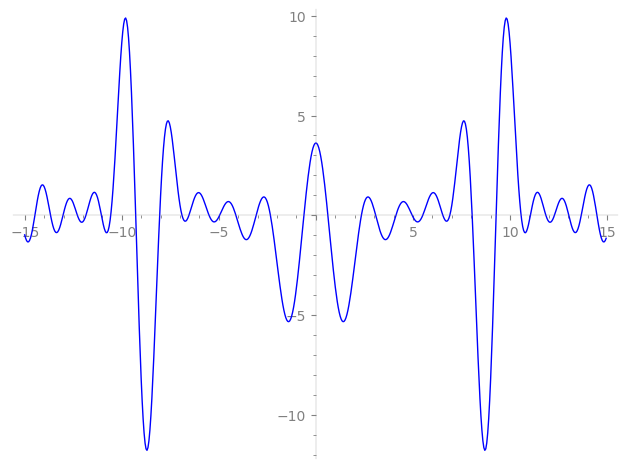| L(s) = 1 | + 10.1·2-s − 12.6·3-s + 72.0·4-s − 25·5-s − 128.·6-s − 65.3·7-s + 408.·8-s − 83.0·9-s − 254.·10-s − 121·11-s − 910.·12-s − 396.·13-s − 667.·14-s + 316.·15-s + 1.86e3·16-s − 1.19e3·17-s − 847.·18-s + 361·19-s − 1.80e3·20-s + 826.·21-s − 1.23e3·22-s + 2.16e3·23-s − 5.16e3·24-s + 625·25-s − 4.04e3·26-s + 4.12e3·27-s − 4.71e3·28-s + ⋯ |
| L(s) = 1 | + 1.80·2-s − 0.811·3-s + 2.25·4-s − 0.447·5-s − 1.46·6-s − 0.504·7-s + 2.25·8-s − 0.341·9-s − 0.806·10-s − 0.301·11-s − 1.82·12-s − 0.651·13-s − 0.909·14-s + 0.362·15-s + 1.81·16-s − 1.00·17-s − 0.616·18-s + 0.229·19-s − 1.00·20-s + 0.409·21-s − 0.543·22-s + 0.851·23-s − 1.83·24-s + 0.200·25-s − 1.17·26-s + 1.08·27-s − 1.13·28-s + ⋯ |
\[\begin{aligned}\Lambda(s)=\mathstrut & 1045 ^{s/2} \, \Gamma_{\C}(s) \, L(s)\cr =\mathstrut & \, \Lambda(6-s) \end{aligned}\]
\[\begin{aligned}\Lambda(s)=\mathstrut & 1045 ^{s/2} \, \Gamma_{\C}(s+5/2) \, L(s)\cr =\mathstrut & \, \Lambda(1-s) \end{aligned}\]
Particular Values
| \(L(3)\) |
\(\approx\) |
\(3.625130825\) |
| \(L(\frac12)\) |
\(\approx\) |
\(3.625130825\) |
| \(L(\frac{7}{2})\) |
|
not available |
| \(L(1)\) |
|
not available |
\(L(s) = \displaystyle \prod_{p} F_p(p^{-s})^{-1} \)
| $p$ | $F_p(T)$ |
|---|
| bad | 5 | \( 1 + 25T \) |
| 11 | \( 1 + 121T \) |
| 19 | \( 1 - 361T \) |
| good | 2 | \( 1 - 10.1T + 32T^{2} \) |
| 3 | \( 1 + 12.6T + 243T^{2} \) |
| 7 | \( 1 + 65.3T + 1.68e4T^{2} \) |
| 13 | \( 1 + 396.T + 3.71e5T^{2} \) |
| 17 | \( 1 + 1.19e3T + 1.41e6T^{2} \) |
| 23 | \( 1 - 2.16e3T + 6.43e6T^{2} \) |
| 29 | \( 1 - 2.92e3T + 2.05e7T^{2} \) |
| 31 | \( 1 - 802.T + 2.86e7T^{2} \) |
| 37 | \( 1 - 1.04e3T + 6.93e7T^{2} \) |
| 41 | \( 1 - 9.04e3T + 1.15e8T^{2} \) |
| 43 | \( 1 + 1.63e4T + 1.47e8T^{2} \) |
| 47 | \( 1 - 2.68e4T + 2.29e8T^{2} \) |
| 53 | \( 1 - 2.30e4T + 4.18e8T^{2} \) |
| 59 | \( 1 + 3.15e4T + 7.14e8T^{2} \) |
| 61 | \( 1 - 2.95e4T + 8.44e8T^{2} \) |
| 67 | \( 1 - 5.26e4T + 1.35e9T^{2} \) |
| 71 | \( 1 + 231.T + 1.80e9T^{2} \) |
| 73 | \( 1 - 5.90e4T + 2.07e9T^{2} \) |
| 79 | \( 1 - 5.63e4T + 3.07e9T^{2} \) |
| 83 | \( 1 - 3.84e4T + 3.93e9T^{2} \) |
| 89 | \( 1 - 9.19e4T + 5.58e9T^{2} \) |
| 97 | \( 1 + 5.52e4T + 8.58e9T^{2} \) |
| show more | |
| show less | |
\(L(s) = \displaystyle\prod_p \ \prod_{j=1}^{2} (1 - \alpha_{j,p}\, p^{-s})^{-1}\)
Imaginary part of the first few zeros on the critical line
−9.282322843659406836274021508921, −8.048537735630585192779712822288, −6.89579560072103097982029115476, −6.54246249480782643901299579604, −5.50121248828066752799908481916, −4.96091596273864840686172049282, −4.11895214385884944557387894196, −3.08022867817702700174303515539, −2.34228634058998271809329144434, −0.61772677861375128053389653690,
0.61772677861375128053389653690, 2.34228634058998271809329144434, 3.08022867817702700174303515539, 4.11895214385884944557387894196, 4.96091596273864840686172049282, 5.50121248828066752799908481916, 6.54246249480782643901299579604, 6.89579560072103097982029115476, 8.048537735630585192779712822288, 9.282322843659406836274021508921

